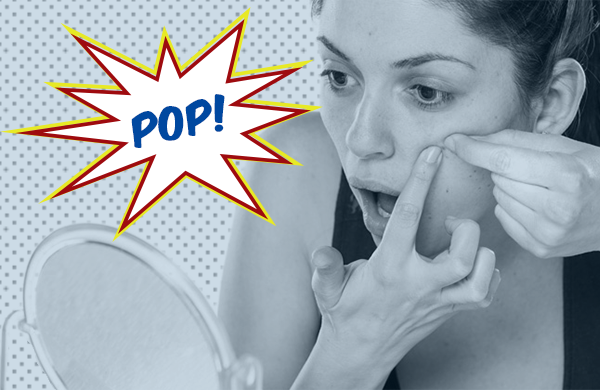
We’ve all been there. Standing in front of the bathroom mirror, eyes fixed on that impossibly huge zit protruding from your face. You know you’re not supposed to pop it, but it’s all you can think about. It’s the dermatologic equivalent of telling someone not to press the big red button.
So what do you do? Ignore it, like the epidermic bully that it is, until it decides to leave you alone? Or squeeze the living daylights out of it against your better judgment? We asked two aestheticians to give it to us straight—here’s what they had to say about why we shouldn’t be popping pimples (and what to do if we absolutely can’t help it).
First of all, some zits aren’t even poppable.
More specifically, those big red ones that seem to radiate pain throughout your entire face.
“I realize the discomfort, swelling, and redness can make it irresistible not to touch, but trust me, timing is everything,” said Amy Halman, a licensed aesthetician and president of Acure Organics. “If it feels deep and a bit painful … clean the area with an alcohol-free cleanser [and] toner and apply ice for a couple of minutes. A great salicylic acid–based spot treatment is perfect to break up the congestion and expedite healing.”
If that doesn’t seem to do the trick after a few days, it might be time to call a pro. “Seeing a professional skin therapist for a treatment is a good idea too, especially if [they use] electrical modalities like high frequency,” suggested Jenifer Goldsmith, an educator at an aesthetics institute. The gentle high-frequency electrical currents “can help accelerate healing of an inflamed lesion by oxygenating it.”
Popping basically guarantees the spread of bacteria.
“There is so much more going on under the skin than just meets the eye,” Jenifer said. “[You] can spread bacteria and create more inflammation.”
How exactly does the bacteria spread? As Amy explained it, “you rupture the pore wall, which causes the infection to spill over into neighboring pores.”
A moment of weakness can lead to years of damage.
“You think [popping a zit] helps it to heal faster, and maybe it will initially,” Amy said. “But you are left with a deeper infection underneath that will surface again and potentially create the dreaded scarring or discolored spot that seems to take years to go away.”
Jenifer echoed Amy’s concerns. In her experience, popping zits can “damage the tissues of the underlying structures, leading to more breakouts, scarring, and hyperpigmentation.”
If you really can’t help yourself, make sure to use protection.
And by that, we mean tissues.
But first, make sure the zit has a sizable pustule (read: whitehead). That’s the poppable part of the pimple. If you can wait until that part is almost completely dried out, it should come off on its own. If it’s not quite there and you’ve run out of patience, Amy supplied these last-resort instructions: “Cleanse the area thoroughly beforehand and apply a warm washcloth to soften the pore. Cover your index fingers with tissue or cotton, and using the sides of your fingers (not the fingertips or nails), apply gentle pressure at the base of the blemish. Be sure to cleanse the area once more [afterward], follow with some salicylic spot treatment, and keep it out of the sun to prevent further discoloration and scarring.”
And if there’s no whitehead, popping won’t help you.
“If you have a blemish that stays deep and never develops to a head, have a dermatologist or licensed professional aesthetician check it out for you,” Amy suggested.
If you’d prefer to handle your business at home, Jenifer recommends applying a product with benzoyl peroxide and salicylic acid two to three times per day until the blemish dries up and heals.
Illustration by Kelly MacDowell, Groupon






